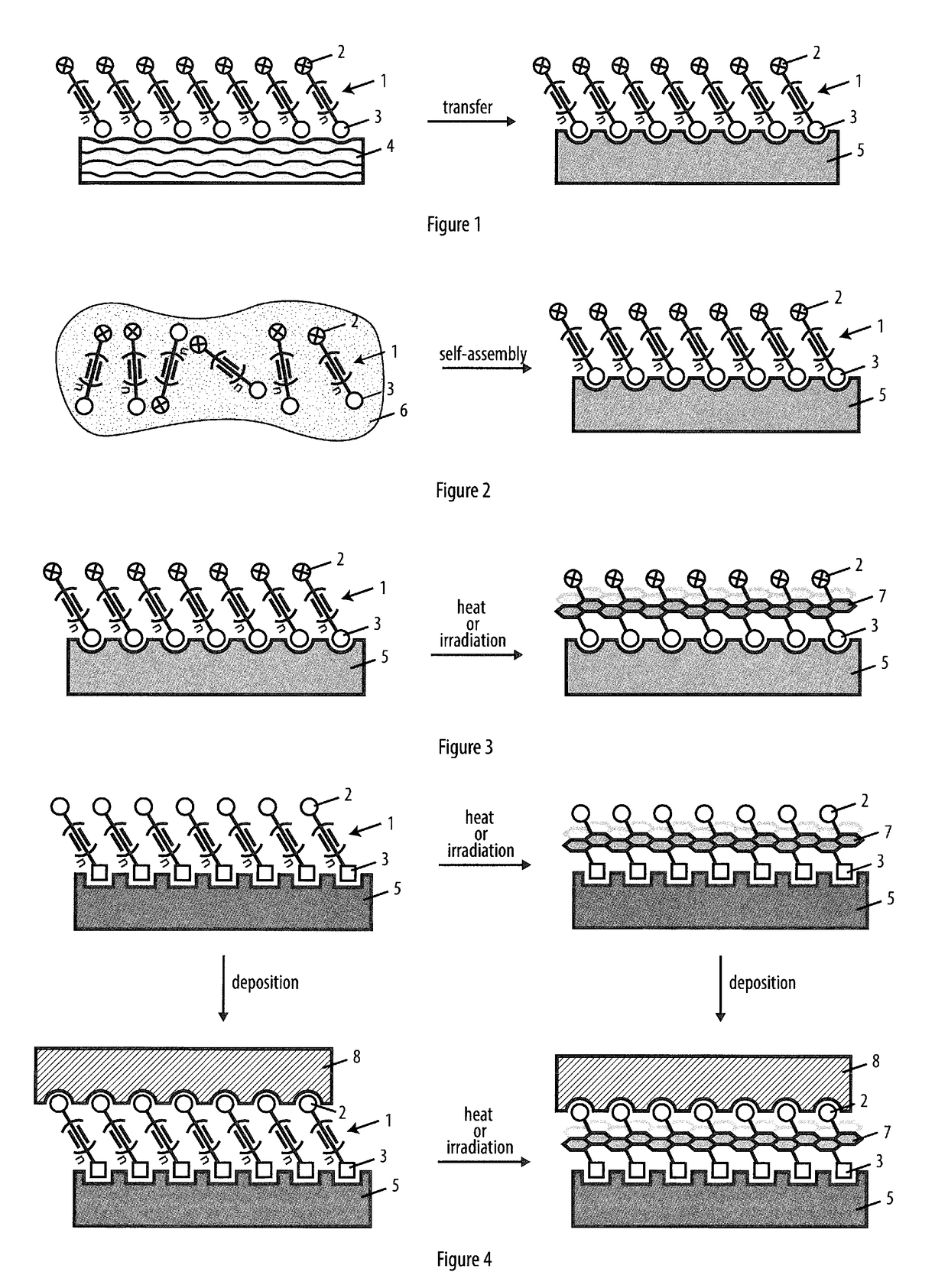Method for the preparation of a coating
a coating and coating technology, applied in the field of coating preparation, can solve the problems of brittle coating mechanical integrity, adversely affecting the properties of materials, optical properties,
- Summary
- Abstract
- Description
- Claims
- Application Information
AI Technical Summary
Benefits of technology
Problems solved by technology
Method used
Image
Examples
example 1 (
Monomer 1, Methyl 16-(triisopropylsilyl)hexadeca-5,7,9,11,13,15-hexaynoate)
[0211]In a flask shielded from light with aluminum foil 4-tritylphenyl-16-(triisopropylsilyl)hexadeca-5,7,9,11,13,15-hexaynoate (240 mg, 0.340 mmol) was dissolved in dichloromethane (DCM) (5 mL) and MeOH (1 mL). NaOMe (65 mg, 0.833 mmol) was added, and the resulting mixture was stirred for 5 hours. Then, Amberlite IR-120 (H+) was added until the solution was neutralized, and the resulting mixture was stirred for 1 hour. The solution was filtered from the Amberlite and transferred into a brown glass vial using a syringe with a fine needle. The crude compound was purified by column chromatography (silica gel; DCM). Freeze-drying yielded methyl 16-(triisopropylsilyl)hexadeca-5,7,9,11,13,15-hexaynoate as a yellow oil that was immediately redissolved in dioxane / MeOH and stored in the refrigerator. 1H NMR (400 MHz, CDCl3) δ 3.68 (s, 3H), 2.43 (dt, J=7.0 Hz, 4.8 Hz, 4H), 1.88 (p, J=7.1 Hz, 2H), 1.09-1.01 (m, 21H). 1...
example 2 (
Monomer 2, Dimethyl icosa-5,7,9,11,13,15-hexaynedioate)
[0212]In a flask shielded from light with aluminum foil 4-tritylphenyl-10-(trimethylsilyl)deca-5,7,9-triynoate (318 mg, 0.545 mmol) was dissolved in DCM (15 mL) and MeCN (10 mL) as well as AgF (83.5 mg, 0.572 mmol) were added. The mixture was stirred for 10 minutes, CuBr2 (133.7 mg, 0.599 mmol) and N,N,N′,N′-tetramethylethane-1,2-diamine (0.18 mL, 1.19 mmol) were added, and stirring was continued for 2 hours. The mixture was diluted with MeOH (10 mL) and NaOMe (136.2 mg, 2.18 mmol) was added. The reaction was stirred for 1 hour, diluted with DCM, washed twice with 1M HCl and once with saturated NaCl solution. The organic phase was dried over Na2SO4 and concentrated in vacuo. Column chromatography (silica gel; CHCl3) yielded dimethyl icosa-5,7,9,11,13,15-hexaynedioate as a yellow solution. For analytical purposes, DMSO-d6 (10 mL) was added, and the mixture was concentrated in vacuo. 1H NMR (400 MHz, DMSO-d6) δ=3.70 (s, 6H), 2.59 ...
example 3 (
Monomer 3, 16-(triisopropylsilyl)hexadeca-5,7,9,11,13,15-hexaynoic acid)
[0213]In a flask shielded from light with aluminum foil methyl 16-(triisopropylsilyl)hexadeca-5,7,9,11,13,15-hexaynoate (280 mg, 0.69 mmol) was dissolved in THF (5 mL) and MeOH (5 mL), water (5 mL), as well as LiOH (30 mg, 1.2 mmol) were consecutively added. The mixture was stirred for 2 hours at room temperature and Amberlite IR-120 (H+) was added until the solution was neutralized, and the resulting mixture was stirred for 30 min. The mixture was filtered, diluted with DCM, washed once with 1M HCl and once with saturated NaCl solution. The organic phase was dried over Na2SO4 and concentrated in vacuo to yield 16-(triisopropylsilyl)hexadeca-5,7,9,11,13,15-hexaynoic acid as a concentrated yellow solution.
PUM
| Property | Measurement | Unit |
|---|---|---|
| Temperature | aaaaa | aaaaa |
| Temperature | aaaaa | aaaaa |
| Temperature | aaaaa | aaaaa |
Abstract
Description
Claims
Application Information
 Login to View More
Login to View More - R&D
- Intellectual Property
- Life Sciences
- Materials
- Tech Scout
- Unparalleled Data Quality
- Higher Quality Content
- 60% Fewer Hallucinations
Browse by: Latest US Patents, China's latest patents, Technical Efficacy Thesaurus, Application Domain, Technology Topic, Popular Technical Reports.
© 2025 PatSnap. All rights reserved.Legal|Privacy policy|Modern Slavery Act Transparency Statement|Sitemap|About US| Contact US: help@patsnap.com



